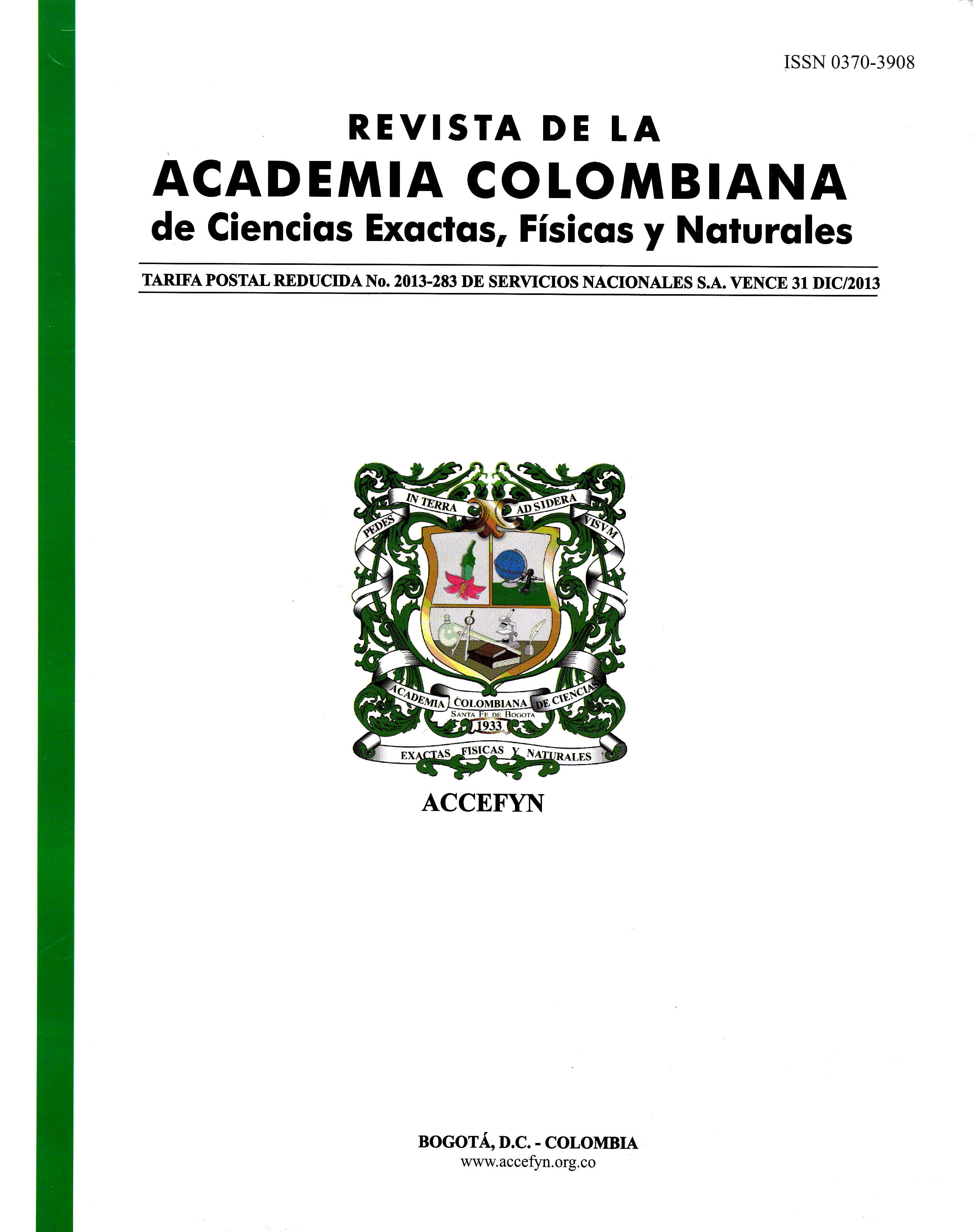Abstract
It was evaluated the effect of the inductors of resistance: salicylic acid, Acibenzolar-S-methyl, 2, 6-dicloroisonicotinic acid, 3-butanoic acid and potassium phosphite, as well as the fungicides Propiconazole and Clorothalonil in seedlings of Dominico-Hartón against Mycosphaerella fijiensis and M. musicola. The experiment consisted of eight treatments and twenty replications per treatment in a completely randomized design. The treatments were applied to the soil at 30, 60 and 75 days after sowing. It was evaluated: seedlings height (cm), index of severity (%), grade of evolution of the sigatokas and rate of disease development (r). Potassium phosphite was the best treatment because the seedlings had a height of 36.6 cm compared to the control which recorded 29 cm, two days of symptoms appearance delay, lower rate of disease development (r = 0.04) and lower values of grade of evolution of symptoms and severity index, which were 1.4 and 6.23%, respectively, while the control showed r = 0.05, 3.4 and 33.02%, respectively. Potassium phosphite was not statistically different from Propiconazole. Except the salicylic and 2,6-dicloroisonicotinic acids, the other inductors of resistance demonstrated that the control of the sigatokas, was the result of the activation of the defense mechanisms of the plants.
Keywords
References
Amzalek E. & Y. Cohen. 2007. Comparative efficacy of systemic acquired resistance inducing compounds against rust infection in sunflower plants. Phytopathology 97:179-186.
Angiolani A. 1960. Introducción a la química industrial. Fundamentos Químicos y Tecnológicos. Editorial Andrés Bello, Santiago de Chile. 697 p.
Aranzazu F., J. Valencia, M. Arcila, C. Castrillón, M. Bolaños & P. Castellanos. 2002. El cultivo de plátano. Manual técnico. CORPOICA, Manizales, Colombia. 114 p.
Arzanlou M., E. Abeln, G. Kema, C. Waalwijk, J. Carlier, I. de Vries, M. Guzmán & P. Crous. 2007. Molecular diagnostics for the Sigatoka disease complex of banana. Phytopathology 97:1112-1118.
Belalcázar S., F. Salazar, J. Valencia, C. Silva, M. Arcila & R. Jaramillo. 1996. Reacción de variedades mejoradas al ataque de la Sigatoka negra (Mycosphaerella fijiensis Morelet). Sigatoka negra y variedades mejoradas de plátano. En: Boletín de Sanidad Vegetal No. 12, Instituto Colombiano Agropecuario (ICA).
Boller T. 1992. Biochemical analysis of chitinases and β-1,3 glucanases. Practical Methods. pp. 23-30. In: Bowles D., S. Gurr. (eds.). Molecular Plant Pathology. Oxford. Carlier J., D. de Waele & J. Escalant. 2002. Evaluación global de la resistencia de los bananos al marchitamiento por Fusarium, enfermedades de las manchas foliares causadas por Mycosphaerella y nematodos. En: Vézina, A., C. Picq. (eds.). Guías técnicas INIBAP 6. Red Internacional para el Mejoramiento del Banano y el Plátano. Montpellier, Francia. 68 p.
Castaño-Zapata, J. 2002. Principios básicos de fitoepidemiología. 1ª edición. Universidad de Caldas, Manizales, Colombia. 398 p. Cohen Y. & M. Coffey. 1986. Systemic fungicides and the control of Oomycetes. Annual Review of Phytopathology 24:311-338.
Dixon R. 2001. Natural products and plant disease resistance. Nature 411:843-847.
Entretenimiento y Desarrollo de Agricultores (EDA). 2008. El uso de ácido salicílico y fosfonatos (fosfitos) para activación del sistema de resistencia adquirida de la planta. En: Boletín Técnico de Producción. Implementado por Fintrac Inc., Fundación Hondureña de Investigación Agrícola y la Escuela Agrícola Panamericana. Honduras, http://www.mcahonduras.hn/documentos/PublicacionesEDA/Manuales%20de%20produccion/EDA_Produccion_Uso_de_Acido_Salicilico_Y_Fosfitos_01_08.pdf 3 p.; consultada: enero. 2011.
Faize M., L. Faize, N. Koike, M. Ishizaka & H. Ishii. 2004. Acibenzolar- S-methyl induced resistance to Japanese pear scabis associated with potentiation of multiple defense responses. Phytopathology 94:604-612.
Friedrich L., K. Lawton, W. Ruess, P. Masner, N. Specker, M. Gut, B. Mejer, S. Dincher, T. Staub, S. Uknes, J. Métraux, H. Kessmann & J. Ryals. 1996. A benzothidiazole derívate induces systemic acquired resistance in tobacco. The Plant Journal 10(1):61-70.
Greenber J. 1997. Programmed cell death in plant-pathogen interactions. Annual Review of Plant Physiology and Plant Molecular Biology 48:525-545.
Köller W. 1992. Antifungal agents with target sites in sterol functions and biosynthesis. pp.119-206. In: Köller, W. (ed.). Target Sites of Fungicide Action. CRC Press. Boca Raton, Florida. 328 p.
Kuc J. 1995. Phytoalexins, stress metabolism, and disease resistance in plants. Annual Review of Phytopathology 33:275-297.
Latunde A. & J. Lucas. 2001. The plant defense activator Acibenzolar-S-Methyl primes cowpea [Vigna unguiculata (L.) Walp.] seedlings for rapid induction of resistance. Physiological and Molecular Plant Pathology 58:199-208.
Lema M. C. 2009. Evaluación del Fosfito de Potasio (Foscrop PK®) como inductor de resistencia en plátano (Musa AAB) para el control de Sigatoka negra (Mycosphaerella fijiensis Morelet) en lotes comerciales del departamento del Quindío. Armenia, Colombia. Trabajo de Grado Bióloga. Universidad del Quindío. 72 p.
Marín D., R. Romero, M. Guzmán & T. Sutton. 2003. Black Sigatoka: en increasing threat to banana cultivation. Plant Disease 87(3):208-222.
Márquez L. & J. Castaño-Zapata. 2007. Inducción de resistencia a sigatokas en plántulas de plátano Dominico-Hartón. Agronomía 15(2):49-57.
Mehrotra R. & A. Aggarwal. 2006. Plant pathology. Second edition. Tata McGraw-Hill, New Delhi. 847 p.
Mogollón-Ortiz A. M. & J. Castaño-Zapata. 2011. Evaluación in vitro de inductores de resistencia sobre Mycosphaerella fijiensis Morelet. Revista Facultad Nacional de Agronomía (En revisión).
Molina O. & J. Castaño-Zapata. 2003. Resistencia en los FHIA híbridos a Mycosphaerella spp. Info Musa 12(2):25-27.
Orober M., J. Siegrist & H. Buchenauer. 2002. Mechanisms of phosphate-induced disease resistance in cucumber. European Journal of Plant Pathology 108:345-353.
Patiño L. F. 2002. Efecto de una fuente de energía, tres inductores de resistencia y un sustrato foliar sobre Sigatoka negra en banano. pp. 135-142. En: Acorbat. Memorias XV reunión. Asociación de Bananeros de Colombia AUGURA. Cartagena de Indias.
Porras A. & L. Pérez. 1997. The role of temperature in the growth of the germ tubes of ascospores of Mycosphaerella spp., responsible for leaf spot diseases of banana. Infu Musa 6(2):27-32.
Siegrist J., M. Orober & H. Buchenauer. 2000. Beta-aminobutyric acid mediated enhancement of resistance in tobacco to Tobacco mosaic virus depends on the accumulation of salicylic acid. Physiological and Molecular Plant Pathology 56:95-106.
Sticher L., B. Mauch-Mani & J. Metraux. 1997. Systemic acquired resistance. Annual Review of Phytopathology 35:235-270.

This work is licensed under a Creative Commons Attribution-NonCommercial-NoDerivatives 4.0 International License.
Copyright (c) 2023 Revista de la Academia Colombiana de Ciencias Exactas, Físicas y Naturales





